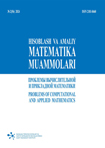SOME ASPECTS OF NUMERICAL ANALYSIS OF THE FRACTIONAL MATHEMATICAL MCSHERRY MODEL FOR DESCRIBING AN ARTIFICIAL ECG
Keywords:
McSherry model, ECG, fractional derivative, numerical algorithm, order of accuracy, Runge’s ruleAbstract
The article examines McSherry’s mathematical model, taking into account heredity, to describe artificial ECGs. The mathematical model consists of three ordinary nonlinear differential equations with derivatives of fractional orders in the Gerasimov-Caputo sense, for which local initial conditions are valid (Cauchy problem). The Cauchy problem is solved using a numerical method based on a nonlocal explicit finite-difference scheme of first order accuracy. The numerical algorithm was implemented in a computer program in the Maple language. Using Runge’s rule, it is shown that the order of computational accuracy of the numerical algorithm tends to the theoretical order as the number of nodes of the computational grid increases. Using a computer program, the simulation results were visualized for various values of the orders of fractional derivatives. It is shown that the orders of fractional derivatives allow a more flexible description of the artificial ECG. It should be noted that the numerical method, which was used in the article, can be applied to a more general mathematical model when the orders of fractional derivatives are functions of time.
References
Hampton J., Hampton J. The ECG Made Easy E-Book: The ECG Made Easy E-Book. Elsevier, 2019.– 240 p.
Schwartz P. J., Wolf S. QT interval prolongation as predictor of sudden death in patients with myocardial infarction // Circulation.– 1978.– Vol. 57, No. 6.– P. 1074-1077.
McSharry P.E. et al. A dynamical model for generating synthetic electrocardiogram signals // IEEE transactions on biomedical engineering.– 2003.– Vol. 50, No. 3.– P. 289-294. doi: http://dx.doi.org/10.1109/TBME.2003.808805.
Alimov KH.T., Dzamikhova F.KH., Parovik R.I. Drobnaya matematicheskaya model' Mak sherri // Vestnik KRAUNTS. Fiz.-mat. nauki.– 2023.– T. 42, № 1.– C. 164-179. doi: http://dx.doi.org/10.26117/2079-6641-2023-42-1-164-179.
Volterra V. Functional theory, integral and integro-differential equations.– New York: Dover, 2005.– 288 p.
Uchaykin V.V. Metod drobnykh proizvodnykh.– Ul'yanovsk: Artishok, 2008.– 510 s.
Martsenyuk V.P., Sarabun R.O. Issledovaniye nelineynoy dinamiki v modeli MakSherri na osnove eksponent Lyapunova // Vestnik Voronezhskogo gosudarstvennogo universiteta. Seriya: Sistemnyy analiz i informatsionnyye tekhnologii.– 2014.– № 2.– S. 57-61.
Gomez-Aguilar J.F., Razo-Hernandez R., Granados-Lieberman D. A physical interpretation of fractional calculus in observables terms: analysis of the fractional time constant and the transitory response // Revista Mexicana de F· ısica.– 2014.– No. 60.– З. 32-38.
Gerasimov A.N. Obobshcheniye zakonov lineynogo deformirovaniya i ikh primeneniye k zadacham vnutrennego treniya // Prikladnaya matematika i mekhanika.– 1948.– T. 44, №6.– S. 62-78.
Caputo M. Linear models of dissipation whose Q is almost frequency independent- II // Geophysical Journal International.– 1967.– Vol. 13.– P. 529-539.
Gavrilyuk I. et al. Exact and truncated difference schemes for boundary value ODEs. Basel: Springer, 2011.– 247 p.
Thompson I. Understanding Maple.– UK: Cambridge University Press, 2016.– 228 p.





